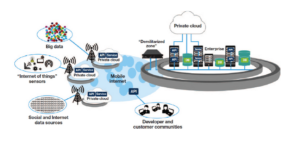End users and software providers are demanding more of the telecommunication industry. While end users request personalized services, better performance, and better user experience, businesses need to get more information about their consumers, easier access to devices and greater flexibility for provisioning new services. There is a key role to play for equipment providers, service providers and IT players to together make this a reality by providing converged IT and network infrastructure leveraging small cell systems for coverage, capacity and localized services.
The worlds of cloud computing and networking are converging into a new form of infrastructure we could define as edge clouds. An edge cloud can be seen as a small cell environment running at the edge of a telecommunication network and performing specific tasks that could not be well achieved by traditional cloud technologies. Machine-to-machine gateway and control functions are one example, but there are many others.
Typically, an edge cloud is characterized by
- On-Premise: An Edge Cloud is local, meaning that it can run isolated from the rest of the network, while having access to local resources. This becomes particularly important for machine-to-machine scenarios, for example when dealing with security or safety systems that need high levels of resilience.
- Proximity: Being close to the source of information, edge clouds are particularly useful to capture key information for analytics and big data. They also have direct access to the devices, which may easily be leveraged by business specific applications.
- Lower latency: Cloud services running closer to end devices considerably reduce latency. This can be exploited to react faster, to improve user experience, or to minimize congestion in other parts of the network leveraging small cell systems for coverage, capacity and localized services.
- Location awareness: When an edge cloud is part of a wireless network, whether it is Wi-Fi or cellular, a local cloud service can leverage low-level signaling information to determine the location of each connected device. This gives birth to an entire family of business-oriented use cases, including location-based services, analytics and many more.
- Decentralized: While traditional clouds are centralized, edge clouds are distributed at the very end of the network, close to the access points. This changes the way services are managed and orchestrated.

A new era of localized and personalized edge computing is already here.
Other articles in this series:
The enterprise is the edge of the network
LBS and asset tracking using small cell systems
